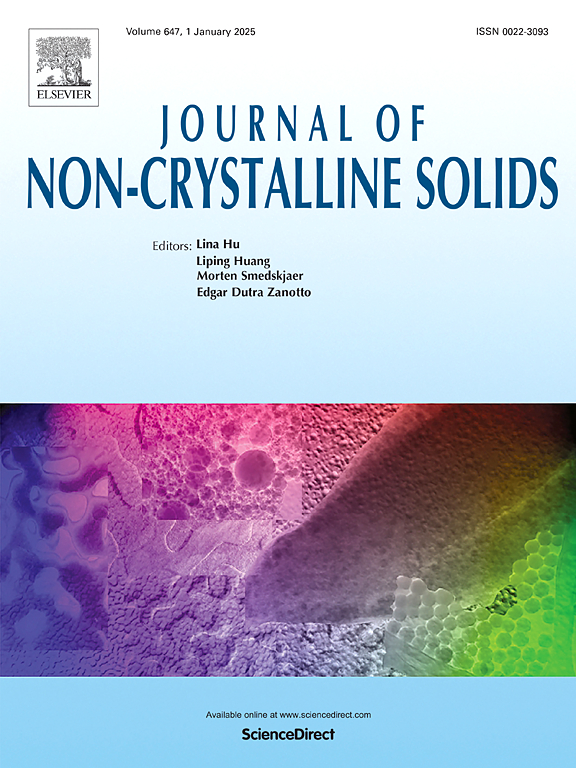无定形二氧化硅表面从液态到玻璃态的结构和电子构型
IF 3.2
3区 材料科学
Q1 MATERIALS SCIENCE, CERAMICS
引用次数: 0
摘要
通过经典的分子动力学计算模拟,在一个由 64 个二氧化硅分子(192 个原子)组成的系统中,通过经典的三体玻璃势生成了无定形二氧化硅(玻璃状二氧化硅)的表面。从开氏 3400 度的液态二氧化硅开始,以每秒 4.4 K 的冷却速度,在开氏 200 度、400 度和 2000 度之间以三种不同的方式进行冷却,并在中间温度建立弛豫,产生了开氏 3400 度至 1400 度的三组表面。随后,这些系统通过安德森恒温器和诺塞-胡佛恒温器经历了开氏 1400 度至 300 度的骤冷,然后在开氏 300 度时通过微观规范集合(NVE 常量)进行弛豫。每个经过弛豫的表面都通过 ab initio 分子动力学分析了以下三个与温度有关的物理特性。氧和硅的平均电荷。观察了表面最外层的微结构,包括非杂化氧原子、欠配位硅和 N 元环(3 ≤ N ≤ 5)。对所有表面的径向分布函数进行了分析。开氏 2000 度以下时,由于玻璃化转变,所有结构都会出现冻结现象。所有分析均在零压力下进行。本文章由计算机程序翻译,如有差异,请以英文原文为准。
The structural and electronic configuration of an amorphous silica surface, from its liquid to glassy state
Through classical molecular dynamics computational simulations, the surface of amorphous silica (vitreous silica) was generated for a system comprising 64 SiO2 molecules (192 atoms) via the classical three-body glass potential. Starting from the liquid state of silica at 3400 K, it was cooled in three different ways at intervals of 200, 400, and 2000 K, with a cooling rate of 4.4 K/ps and establishing relaxation at intermediate temperatures, yielding three groups of surfaces from 3400 to 1400 K. Subsequently, these systems underwent sudden cooling from 1400 to 300 K via the Andersen and Nosé‒Hoover thermostats, followed by relaxation at 300 K via a microcanonical ensemble (NVE constant). Each surface that underwent relaxation was analyzed through ab initio molecular dynamics for the following three physical properties, which are temperature dependent. The average electric charges of oxygen and silicon. Microstructures on the outermost part of the surface were observed and comprised nonbridging oxygen atoms, undercoordinated silicon, and N-membered rings (3 ≤ N ≤ 5). The radial distribution functions were analyzed for all surfaces. Below 2000 K, a type of freezing is observed in all the structures because of the glass transition. All analyses were performed at zero pressure.
求助全文
通过发布文献求助,成功后即可免费获取论文全文。
去求助
来源期刊

Journal of Non-crystalline Solids
工程技术-材料科学:硅酸盐
CiteScore
6.50
自引率
11.40%
发文量
576
审稿时长
35 days
期刊介绍:
The Journal of Non-Crystalline Solids publishes review articles, research papers, and Letters to the Editor on amorphous and glassy materials, including inorganic, organic, polymeric, hybrid and metallic systems. Papers on partially glassy materials, such as glass-ceramics and glass-matrix composites, and papers involving the liquid state are also included in so far as the properties of the liquid are relevant for the formation of the solid.
In all cases the papers must demonstrate both novelty and importance to the field, by way of significant advances in understanding or application of non-crystalline solids; in the case of Letters, a compelling case must also be made for expedited handling.
 求助内容:
求助内容: 应助结果提醒方式:
应助结果提醒方式:


